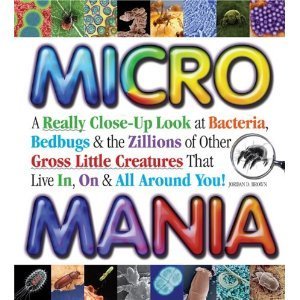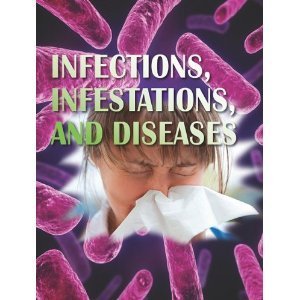Three For One! Germs, Diseases, and Gross Little Creatures
A Really Close-Up Look at Bacteria, Bedbugs, and the Zillions of Other Gross Little Creatures that Live In, On, and All Around You!
By Jordan D. Brown
Imagine Publishing, 2009; reprint, 2011
ISBN-13: 978-1936140473
Ages 9-12
Nonfiction
Which leads to:
By Richard Platt
Illustrated by John Kelly
Kingfisher, 2011
ISBN-13: 978-0753466872
Ages 9-12
Nonfiction
And then we go on to my take on the topic:
Infections, Infestations, and Diseases
By Shirley Duke
Rourke, 2011
Ages 9-12
Nonfiction
Take a closer look at all three books.
MICRO MANIA
"Try not to panic, but there are billions of tiny creatures crawling all over your skin. They are wriggling on your legs, your arms, your nec, your scalp… EVERYWHERE!"
Micro Mania covers the world of bacteria, pests such as fleas and ticks, food pests like ants, roaches, beetles, and moths, along with kitchen bacteria and where they all live and reproduce. Then the information moves to the bedroom and bathroom, with dust mites, bed bugs, and algae. Plankton, krill, and thermophiles round out the mix of these mini creatures that live with us. The book reveals the amazing characteristics of these organisms and presents the information in a medium gross way that should appeal to this age.
Activity
Look up information about the life cycle of a flea. Then read about the Bubonic Plague. Write a paragraph explaining what part fleas played in the plague's transmission.
Read about the flea life cycle here.
Here's some basic bubonic plague information.
PLAGUES, POX, and PESTILENCE
"Do you dare step inside the Pox Lab? In here, we study the history of the world's most horrible diseases."
Plagues, Pox, and Pestilence takes the reader deep into the story of diseases in this fascinating book. It includes the story of great epidemics, the people who made history in germs and disease prevention, and how science has provided the technology to fight these invaders today. The final chapter talks about the future of poxes and plagues.
The type adds to the fun of reading this book. It contains a thorough glossary of poxy words and an index. Bright, cartoonish characters add to the action and narration. This is another books kids should love.
Activity
Develop a timeline of scientific discoveries using the information from the book.
Here's a comprehensive example, but it would need to be narrowed to the examples used in the book.
INFECTIONS, INFESTATIONS, AND DISEASES
"Achoo!"
"Where's the Kleenex?"
"I don't feel well."
How many times has a teacher moved back or a mom has hurried to get the thermometer? Or you've checked for nits, worried over vaccines, or stayed up most of the night with a sick child? This book is a starting point for kids interested in what makes you sick or those who are curious about the world and themselves.
The first three chapters address the meaning of the title, covering health and illness, infestations, and then diseases. The next chapter continues with how they are spread, prevention and treatment, and eliminated and emerging diseases. The book addresses current topics like bed bugs, HIV, and the H1N1 flu virus. It has a table of contents, glossary, index, and suggested websites to visit.
Health is important to everyone, and eager young scientists and kids alike should enjoy the fascinating facts in the book. Each book in the series has straightforward science and facts presented in an interesting way to readers. I'm writing three new books for Rourke in the coming year. I can't wait to blog on them, too!
Activity 1
Research how to wash hands properly. Create a poster to display the correct techniques and practice singing happy birthday two times to show children how long they should spend scrubbing them.
The CDC has a child-friendly set of directions.
The Mayo clinic has additional information about dos and don'ts for hand washing.
Activity 2 (for older kids)
Look at the comparisons of hands that have been washed or cleaned in various ways. Draw a conclusion about the most sanitary means of cleaning hands and write a paragraph about how to properly wash hands to remove bacteria.
You can find good information and pictures here.
Here you'll find more interesting bacteria and hands information.
National Science Standards: biodiversity and humans; growth and development of organisms
Books provided by the individual publishers.








Shirley Smith Duke's Blog





